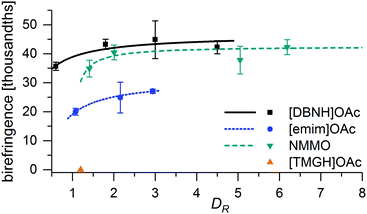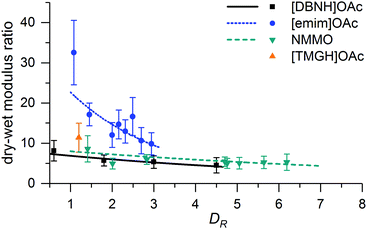 Open Access Article
Open Access ArticleCreative Commons Attribution 3.0 Unported Licence
Correction: Cellulose regeneration and spinnability from ionic liquids
Lauri K. J.
Hauru
,
Michael
Hummel
,
Kaarlo
Nieminen
,
Anne
Michud
and
Herbert
Sixta
*
Department of Forest Products Technology, Aalto University, School of Chemical Engineering, P. O. Box 16300, 00076 Aalto, Espoo, Finland. E-mail: herbert.sixta@aalto.fi
First published on 14th June 2017
Abstract
Correction for ‘Cellulose regeneration and spinnability from ionic liquids’ by Lauri K. J. Hauru et al., Soft Matter, 2016, 12, 1487–1495.
For the spinning system, the manufacturer's software reported an incorrect extrusion flow rate ve (ml min−1) when using the smaller cylinder. Thus, the error only affects [DBNH]OAc and [TMGH]OAc; NMMO and [emim]OAc data remains intact. The correct values for ve may be obtained by multiplying the reported ve with 1/0.6. As DR is determined from ve, it is also affected: to obtain correct DR, multiply the reported DR with 0.6. The extrusion velocities (ve) and draw ratios (DR) reported for [DBNH]OAc and [TMGH]OAc in the main text are modified as follows:
| ve [ml min−1] | DR | ||
|---|---|---|---|
| Reported | Correct | Reported | Correct |
| 0.02 | 0.033 | 1.0 | 0.6 |
| 0.04 | 0.067 | 2.0 | 1.2 |
| 7.5 | 4.5 | ||
| 12.5 | 7.5 | ||
In the section “Practical spinning”, the sentence beginning “Spinnability was good…” should be modified as follows:
“Spinnability was good for [DBNH]OAc (up to DR4.5), but poor for [TMGH]OAc (only DR1.2).”
The corrected Table 2 is as follows:
| Spinning solvent | d 0 [μm] | T extr [°C] | T bath [°C] | D Rmax | Titer [dtex] | Tenacity [cN tex−1] |
|---|---|---|---|---|---|---|
| d 0, spinneret diameter; Textr, extrusion temperature; Tbath, regeneration bath temperature; DRmax, highest draw ratio spun. | ||||||
| [DBNH]OAc | 100 | 70 | 15 | 4.5 | 3.0 ± 0.9 | 38.5 ± 8.4 |
| NMMO·H2O | 100 | 95 | 15 | 6.2 | 3.7 ± 0.7 | 31.2 ± 6.6 |
| [TMGH]OAc | 100 | 80 | 15 | 1.2 | 15.5 ± 0.9 | 10.9 ± 1.1 |
| [emim]OAc | 250 | 90 | 45 | 2.9 | 44.4 ± 1.7 | 13.9 ± 1.6 |
Modified Fig. 8 and 9 are as follows:
The conclusions remain intact. The lower draw ratio exhibited by [TMGH]OAc solutions (1.2 instead of 2.0) actually adds credence to the stated conclusions about [TMGH]OAc. For [DBNH]OAc, the lower draw ratio is not an issue, since it is known from the outset that a monofilament system is suboptimal and better results can be obtained with a multifilament system.
The Royal Society of Chemistry apologises for these errors and any consequent inconvenience to authors and readers.
| This journal is © The Royal Society of Chemistry 2017 |


